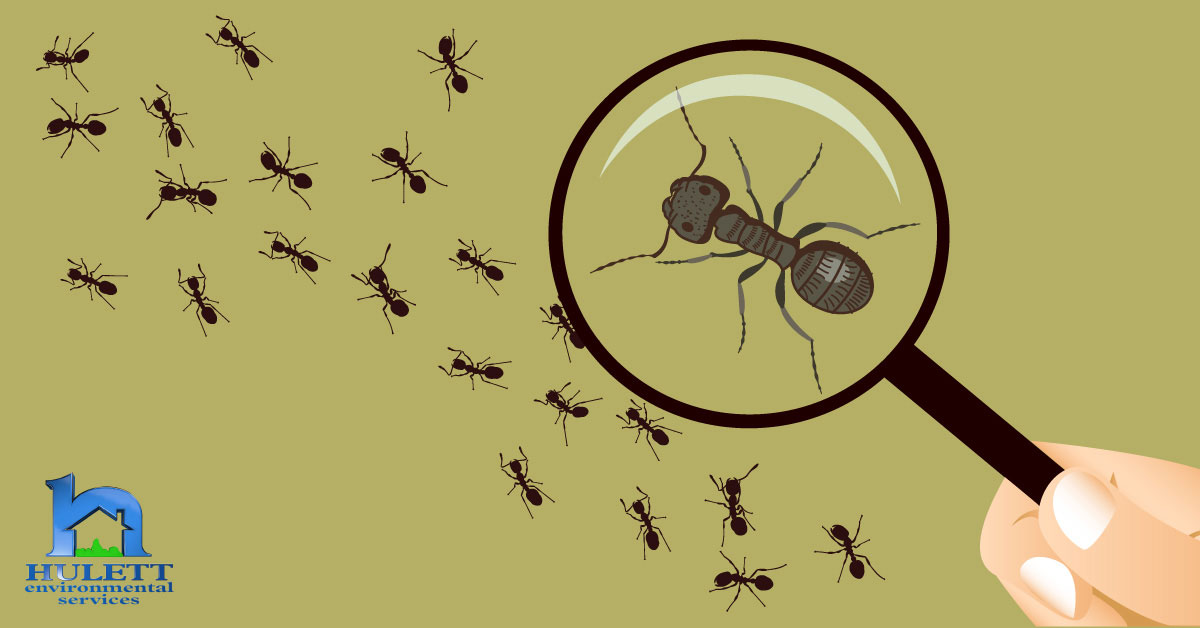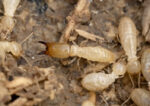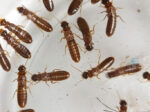
Ant Spotlight: Florida Carpenter Ants
The source of more South Florida homeowner complaints than any other of the sunshine state’s ant species, Florida carpenter ants, make more appearances inside structures than all of Florida’s ant species combined. One reason homeowners panic when they detect these large bi-colored ants seems to be a case of mistaken identity. It doesn’t help these arboreal ants’ reputation that they swarm in alarming numbers during mating season, between April and November and can be mistaken for termites. While winged ant reproductives, called alates and winged subterranean termite alates look similar, on closer inspection, slight but significant differences in termites and ants include: Ant alates (Winged Ants)
- Elbowed antennae
- Larger fore wings than hind wings
- A constricted waist
Termite alate: (Winged or Subterranean Termites)
- Beaded antennae
- Two sets of equal length wings
- A broad waist
The Florida Carpenter Ant vs the Black Carpenter Ant Homeowners, fearing for the structural integrity of their homes, also mistake Florida carpenter ants for the destructive black carpenter ant that burrows through the structural wood in your home, causing almost as much damage as termites. Florida carpenter ants will nest in damp or decaying wood cavities inside structures but don’t carve out galleries in sound wood and damage your home. Two species of Florida carpenter ants are common in South Florida homes Camponatus floridanus, is widely distributed throughout Florida and neighboring states, while Camponatus tortuganus is limited to central and southern Florida. According to the University of Florida’s (UF) insect index, “the ratio of C. floridanus to C. totuganus is about 2:1 in South Florida.” Largest ants in South Florida Florida carpenter ants range in size, with workers measuring 1/4″ to 3/8″ in length and the largest, winged female alates measuring little over 3/4″ in length. With ash brown to rusty-orange thoraxes and heads and black abdomens, Florida carpenter ants sport long, abundant golden hairs all over their bodies and 12 segmented, elbowed antennae. Stinging vs. biting Another reason homeowners contact pest control professionals more about Florida carpenter ants, has to do with the myth that these large ants sting and can cause allergic reactions. However, this is not the case. Florida carpenter ants do not possess stingers; however, these ants do have large mandibles and when threatened, will bite intruders. Their bites can break the skin and cause pain because they may inject a defensive chemical, called formic acid into the bite site. Although painful, the formic acid in carpenter ant bites is not venomous and poses no serious health threats to humans or pets. Florida carpenter ants are attracted to sugary foods Tending to forage at night, with peak foraging hours just before sunset and just before dawn, some Florida carpenter ants forage in loosely defined trails, as well as some wandering individual ants. In nature, Florida carpenter ants prefer floral nectars and honeydew produced by aphids, scale and mealy bugs. Carpenter ants also eat other living or dead insects. In your home, Florida carpenter ants can be found in your kitchen in search of sugary snacks. Damp places to nest are best Florida carpenter ants seek moisture and damp places to nest, like under your dishwasher or other places in your kitchen and bathrooms near water leaks. Preferring damp voids for nesting, Florida carpenter ants prefer locations close to sweet food sources, safe from predators, such as birds and lizards and out of the heat and other environmental extremes, such as flooding. Indoors: In addition to moist wall voids, Florida carpenter ants nest under attic insulation and under eaves, as they are acrobatic in trailing across wires and cables attached to your home. These ants are prone to nest under damp windows and door frames, in bags and boxes, under appliances, in flat roofs and behind wooden panels. Sometimes, Florida carpenter ant nests have even been located in electrical boxes and computer printers. Outdoors: While Florida carpenter ants will hollow out damp wood, dead tree trunks and other damaged wood, they do not attack sound wood. They are also attracted to old leaf petioles in palms, under bark, tree roots, especially citrus trees, all kinds of debris, coconuts on the ground, old fences and decks, old shoes, in expansion joints, under rocks, exterior wood, patio ceilings and the list goes on. Contact a professional Finding the nests created by carpenter ants can be challenging and carpenter ant colonies can number several thousand and contain many satellite nests. Hulett suggests contacting a trusted pest control professional. The entomologist-trained technicians at Hulett will inspect your property and recommend environmentally responsible materials and treatments utilizing our Integrated Pest Management (IPM) system. South Florida homes are subjected to numerous household pests that can damage your home, harm your loved ones and just be downright annoying. Hulett’s Healthy Home Program creates a barrier around your home to safeguard your property and loved ones year-round, from household pests. We guarantee you will be satisfied. Contact us to schedule a free pest inspection today. Just call Hulett at (866) 611-BUGS!



